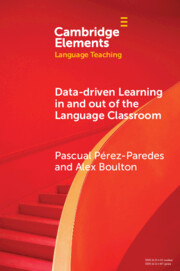Element contents
Data-driven Learning in and out of the Language Classroom
Published online by Cambridge University Press: 16 May 2025
Summary
Keywords
Information
- Type
- Element
- Information
- Series: Elements in Language TeachingOnline ISBN: 9781009511384Publisher: Cambridge University PressPrint publication: 12 June 2025
References
Accessibility standard: Unknown
Why this information is here
This section outlines the accessibility features of this content - including support for screen readers, full keyboard navigation and high-contrast display options. This may not be relevant for you.Accessibility Information
Supplementary materials for this Element are available here.
- 2
- Cited by
